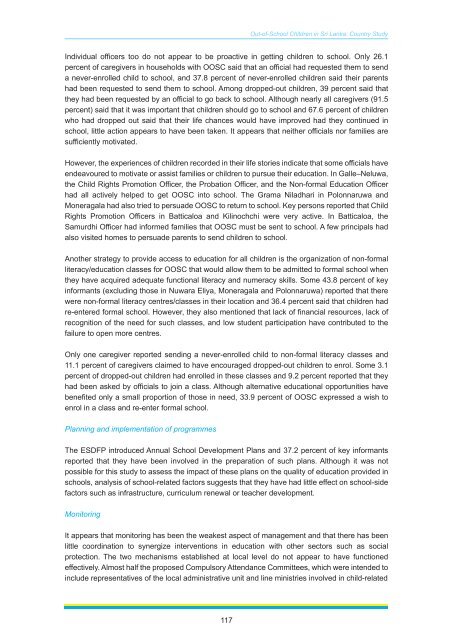Sri Lanka - Institut de statistique de l'Unesco
Sri Lanka - Institut de statistique de l'Unesco
Sri Lanka - Institut de statistique de l'Unesco
Create successful ePaper yourself
Turn your PDF publications into a flip-book with our unique Google optimized e-Paper software.
Out-of-School Children in <strong>Sri</strong> <strong>Lanka</strong>: Country Study<br />
Individual officers too do not appear to be proactive in getting children to school. Only 26.1<br />
percent of caregivers in households with OOSC said that an official had requested them to send<br />
a never-enrolled child to school, and 37.8 percent of never-enrolled children said their parents<br />
had been requested to send them to school. Among dropped-out children, 39 percent said that<br />
they had been requested by an official to go back to school. Although nearly all caregivers (91.5<br />
percent) said that it was important that children should go to school and 67.6 percent of children<br />
who had dropped out said that their life chances would have improved had they continued in<br />
school, little action appears to have been taken. It appears that neither officials nor families are<br />
sufficiently motivated.<br />
However, the experiences of children recor<strong>de</strong>d in their life stories indicate that some officials have<br />
en<strong>de</strong>avoured to motivate or assist families or children to pursue their education. In Galle–Neluwa,<br />
the Child Rights Promotion Officer, the Probation Officer, and the Non-formal Education Officer<br />
had all actively helped to get OOSC into school. The Grama Niladhari in Polonnaruwa and<br />
Moneragala had also tried to persua<strong>de</strong> OOSC to return to school. Key persons reported that Child<br />
Rights Promotion Officers in Batticaloa and Kilinochchi were very active. In Batticaloa, the<br />
Samurdhi Officer had informed families that OOSC must be sent to school. A few principals had<br />
also visited homes to persua<strong>de</strong> parents to send children to school.<br />
Another strategy to provi<strong>de</strong> access to education for all children is the organization of non-formal<br />
literacy/education classes for OOSC that would allow them to be admitted to formal school when<br />
they have acquired a<strong>de</strong>quate functional literacy and numeracy skills. Some 43.8 percent of key<br />
informants (excluding those in Nuwara Eliya, Moneragala and Polonnaruwa) reported that there<br />
were non-formal literacy centres/classes in their location and 36.4 percent said that children had<br />
re-entered formal school. However, they also mentioned that lack of financial resources, lack of<br />
recognition of the need for such classes, and low stu<strong>de</strong>nt participation have contributed to the<br />
failure to open more centres.<br />
Only one caregiver reported sending a never-enrolled child to non-formal literacy classes and<br />
11.1 percent of caregivers claimed to have encouraged dropped-out children to enrol. Some 3.1<br />
percent of dropped-out children had enrolled in these classes and 9.2 percent reported that they<br />
had been asked by officials to join a class. Although alternative educational opportunities have<br />
benefited only a small proportion of those in need, 33.9 percent of OOSC expressed a wish to<br />
enrol in a class and re-enter formal school.<br />
Planning and implementation of programmes<br />
The ESDFP introduced Annual School Development Plans and 37.2 percent of key informants<br />
reported that they have been involved in the preparation of such plans. Although it was not<br />
possible for this study to assess the impact of these plans on the quality of education provi<strong>de</strong>d in<br />
schools, analysis of school-related factors suggests that they have had little effect on school-si<strong>de</strong><br />
factors such as infrastructure, curriculum renewal or teacher <strong>de</strong>velopment.<br />
Monitoring<br />
It appears that monitoring has been the weakest aspect of management and that there has been<br />
little coordination to synergize interventions in education with other sectors such as social<br />
protection. The two mechanisms established at local level do not appear to have functioned<br />
effectively. Almost half the proposed Compulsory Attendance Committees, which were inten<strong>de</strong>d to<br />
inclu<strong>de</strong> representatives of the local administrative unit and line ministries involved in child-related<br />
117

















